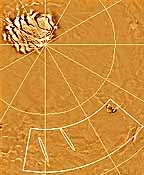| . |  |
. |
 Pasadena - August 25, 1999 - A strip of gentle, rolling plains near the Martian south pole will serve as a welcome mat when NASA's Mars Polar Lander touches down on the red planet on December 3.
Pasadena - August 25, 1999 - A strip of gentle, rolling plains near the Martian south pole will serve as a welcome mat when NASA's Mars Polar Lander touches down on the red planet on December 3.NASA unveiled the landing site, a swath of terrain measuring about 4,000 square kilometers (1,500 square miles), at a briefing today at NASA Headquarters, Washington, DC. "We looked for a site with slopes no steeper than 10 degrees," said Project Scientist Dr. Richard Zurek of NASA's Jet Propulsion Laboratory, Pasadena, CA. "We chose a location with some surface features but no cliffs or jagged peaks, because the spacecraft will be able to land safely, yet we'll still accomplish our science goals." The landing site is located at 76 degrees south latitude and 195 degrees west longitude, near the northern edge of the layered terrain in the vicinity of the Martian south pole. "We believe this layered terrain is a record of climate changes on Mars and, in a sense, digging into its surface will be like reading tree rings or layers in an ice core," Zurek said. "The presence of fine layers of dust and ice with varying thickness will indicate changes in weather patterns and layer formation that have been repeated in recent history. In addition, we may find evidence of soil particles that formed in ancient seas on Mars and were later blown into the polar regions," added Zurek. The landing will be targeted to the center of the site, a rectangular area 200 kilometers (125 miles) long and 20 kilometers (12-1/2 miles) wide. The site was selected after the project team studied pictures and altimeter information gathered by NASA's Mars Global Surveyor, which is currently orbiting the planet. The search was narrowed to four sites before the final location was chosen. A backup landing site is located nearby, at 75 degrees south latitude and 180 degrees west longitude. "For the next several weeks, we'll study newly transmitted Mars Global Surveyor images," said Flight Team Manager Dr. Sam Thurman at JPL. "If necessary, we can retarget for the backup landing site as late as early October, when the flight team begins preparations for landing." The December 3 landing occurs toward the end of spring in the Martian southern hemisphere. The sun will shine all day, moving higher and lower in the sky but never dipping below the horizon. This nonstop sunshine will power the lander's solar panels for 90 days, until the Martian seasons change and the lander's mission ends. Launched on January 3, 1999, Mars Polar Lander will study the soil and look for ice beneath the surface of the Martian south pole. The lander also carries two Deep Space 2 microprobes that will be deployed about five minutes before the spacecraft enters the Martian atmosphere. The microprobes will smash into the planet's surface and penetrate the soil to look for water ice. The microprobes were developed under NASA's New Millennium Program.
Mars 98 Reports From Spacer.Com
Areography
|
| |||||||||
| The content herein, unless otherwise known to be public domain, are Copyright 1995-2016 - Space Media Network. All websites are published in Australia and are solely subject to Australian law and governed by Fair Use principals for news reporting and research purposes. AFP, UPI and IANS news wire stories are copyright Agence France-Presse, United Press International and Indo-Asia News Service. ESA news reports are copyright European Space Agency. All NASA sourced material is public domain. Additional copyrights may apply in whole or part to other bona fide parties. Advertising does not imply endorsement, agreement or approval of any opinions, statements or information provided by Space Media Network on any Web page published or hosted by Space Media Network. Privacy Statement All images and articles appearing on Space Media Network have been edited or digitally altered in some way. Any requests to remove copyright material will be acted upon in a timely and appropriate manner. Any attempt to extort money from Space Media Network will be ignored and reported to Australian Law Enforcement Agencies as a potential case of financial fraud involving the use of a telephonic carriage device or postal service. |